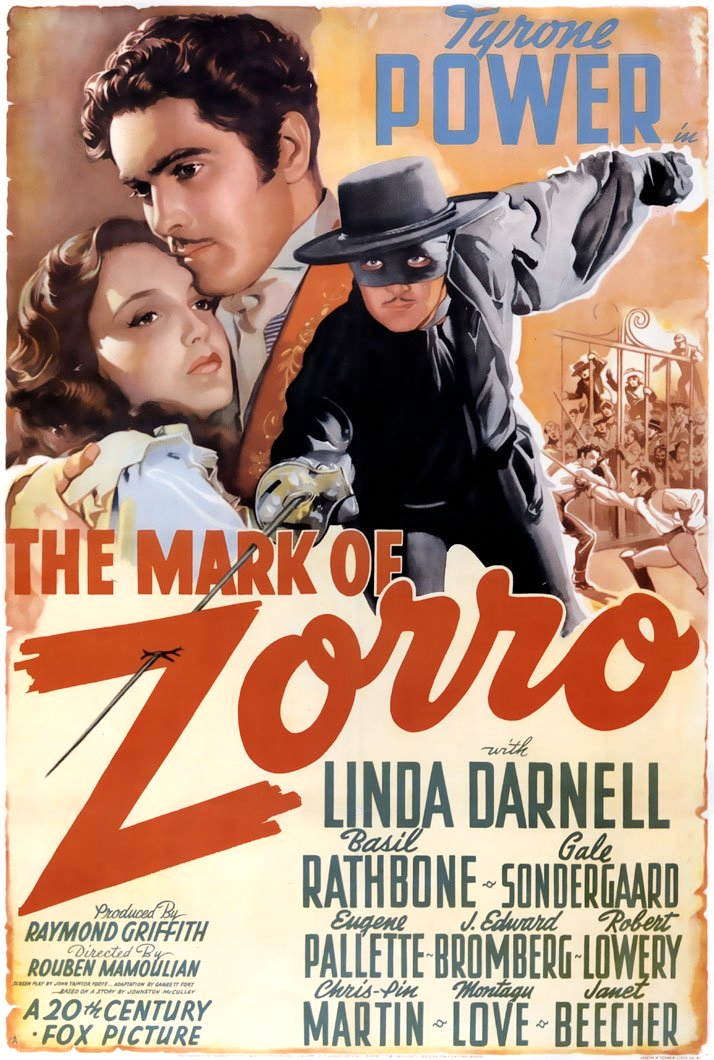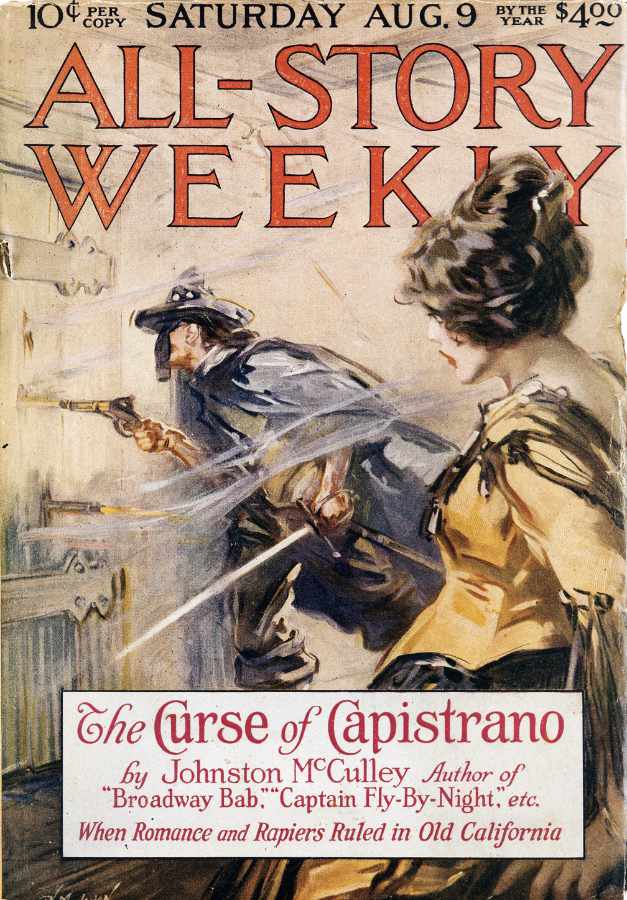Zorro made his debut in “The Curse of Capistrano” in All-Story Weekly, serialized in five parts, from August 9, 1919 to September 6, 1919), by Johnston McCulley. In The Curse of Capistrano, Señor Zorro became an outlaw in the pueblo of Los Angeles in California “to avenge the helpless, to punish cruel politicians, to aid the oppressed” and is dubbed the “Curse of Capistrano”. The novel features extensively both Don Diego Vega and Zorro, but the fact that they are the same person is not revealed to the reader until the end of the book. In the story, both Diego and Zorro romance Lolita Pulido, an impoverished noblewoman. While Lolita is unimpressed with Diego, who pretends to be a passionless fop, she is attracted to the dashing Zorro. The main villain is Captain Ramon, who also has his eyes on Lolita. Other characters include Sgt. Pedro Gonzales, Zorro’s enemy but Diego’s friend; Diego’s deaf and mute servant Bernardo; his ally, Fray (Friar) Felipe; his father Don Alejandro Vega, the richest landowner in California and a widower; Don Carlos Pulido and his wife, Doña Catalina, Lolita’s parents; and a group of noblemen (caballeros) who, at first, hunt Zorro but are then won over to his cause. McCulley’s stories are set during the era of Spanish California (1769–1821) and, although exact years are often vague, the presence of the Pueblo of Los Angeles means the stories cannot happen before 1781, the year it was founded. The character’s visual motif is typically a black costume with a black flowing Spanish cloak or cloak, a black flat-brimmed hat known as sombrero cordobés, and a black sackcloth mask that covers the top half of his head. Sometimes the mask is a two piece, the main item being a blindfold-type fabric with slits for the eyes, and the other item being a bandana over the head, so that it is covered even if the hat is removed. His favored weapon is a rapier, which he also uses to often leave his distinctive mark, a Z cut with three quick strokes, on his defeated foes and other objects to “sign his work”. He also uses other weapons, including a bullwhip and a pistol. Zorro is very intelligent and can not only use a complex strategy, prepared before entering the battlefield, but also improvise plans in the moment of danger and combat. He never uses brute force and, indeed, more often than not he uses humor and psychological teasing to irritate his opponents, causing them to lose their emotional detachment and become too eager for revenge to be able to coordinate in action and in combat. He fools them by provoking them into his traps. In addition to having exceptional tactical skills, he specializes in infiltrating heavily guarded enemy structures or territories, espionage and improvised explosive devices. His calculating and precise ability as a tactician allowed him to also use weapons as an extension of his skillful hand. He is also a weapons expert and a master of escape and camouflage. He is also good at deciphering numerous languages, both spoken and written. Zorro also masters body language, gestures and symbols, facilitating communication with locals regardless of ethnicity or language. Zorro is an agile athlete and acrobat, using his bullwhip as a gymnastic accoutrement to swing through gaps between city roofs, and is very capable of landing from great heights and taking a fall. Although he is a master swordsman and marksman, he has more than once demonstrated his prowess in unarmed combat against multiple opponents. Keen intelligence and an acute power of observation are two main skills allowing Zorro to surprise, in order to defeat, establishment enemies.
| Alias Zorro |
| Real Names/Alt Names Don Diego Vega |
| Characteristics Hero, Outlaw Hero, Swashbuckler, All Story Universe, Film Characters, Pulp Characters, Wold Newton Universe, Modernism Era, Mexican |
| Creators/Key Contributors Johnston McCulley |
| First Appearance “The Curse of Capistrano” in All-Story Weekly (serialized in five parts, August 9, 1919 – September 6, 1919) |
| First Publisher Frank Munsey [LUM] |
| Appearance List Pulps: “The Curse of Capistrano” in All-Story Weekly (serialized in five parts, August 9, 1919 – September 6, 1919), “Zorro Saves A Friend” in Argosy (November 12, 1932), “Zorro Hunts A Jackal” a.k.a. “Zorro Hunts by Night” in Argosy (April 22, 1933), “The Further Adventures of Zorro” in Argosy (serialized in six parts, May 6, 1922 – June 10, 1922), “Zorro Deals With Treason” in Argosy (August 18, 1934), “Mysterious Don Miguel” in Argosy Weekly (serialized in two parts, September 21, 1935 – September 28, 1935), “Zorro Rides Again” in Argosy (serialized in four parts, October 3, 1931 – October 24, 1931). 55 stories followed, one in Argosy, most in West Magazine, including “Zorro Meets a Rogue” in West Vol. 66 No. 3 (Oct 1947). Novella: The Curse of Capistrano (1919, reissued as The Mark of Zorro in 1924). Film: The Mark of Zorro (1920), À la manière de Zorro (In the Way of Zorro, 1926), Son of Zorro (1925), The Bold Caballero (1936), Zorro Rides Again (serial, 1937), Zorro’s Fighting Legion (serial, 1939), The Mark of Zorro (1940), Son of Zorro (serial, 1947), El Nieto del Zorro (1948), Ghost of Zorro (serial, 1949), The Sign of Zorro (1958), Zorro, the Avenger (1959), El Zorro Escarlata (1959), El zorro escarlata en diligencia fantasma (1959), El Zorro Vengador (1962), et. al. Comics: Hit Comics #55, Four Color Comics #228, 425, 497, 538, 574, 617, 732. |
| Sample Read The Mark of Zorro (1924) [Internet Archive] |
| Description Zorro made his debut in “The Curse of Capistrano” in All-Story Weekly, serialized in five parts, from August 9, 1919 to September 6, 1919), by Johnston McCulley. In The Curse of Capistrano, Señor Zorro became an outlaw in the pueblo of Los Angeles in California “to avenge the helpless, to punish cruel politicians, to aid the oppressed” and is dubbed the “Curse of Capistrano”. The novel features extensively both Don Diego Vega and Zorro, but the fact that they are the same person is not revealed to the reader until the end of the book. In the story, both Diego and Zorro romance Lolita Pulido, an impoverished noblewoman. While Lolita is unimpressed with Diego, who pretends to be a passionless fop, she is attracted to the dashing Zorro. The main villain is Captain Ramon, who also has his eyes on Lolita. Other characters include Sgt. Pedro Gonzales, Zorro’s enemy but Diego’s friend; Diego’s deaf and mute servant Bernardo; his ally, Fray (Friar) Felipe; his father Don Alejandro Vega, the richest landowner in California and a widower; Don Carlos Pulido and his wife, Doña Catalina, Lolita’s parents; and a group of noblemen (caballeros) who, at first, hunt Zorro but are then won over to his cause. McCulley’s stories are set during the era of Spanish California (1769–1821) and, although exact years are often vague, the presence of the Pueblo of Los Angeles means the stories cannot happen before 1781, the year it was founded. The character’s visual motif is typically a black costume with a black flowing Spanish cloak or cloak, a black flat-brimmed hat known as sombrero cordobés, and a black sackcloth mask that covers the top half of his head. Sometimes the mask is a two piece, the main item being a blindfold-type fabric with slits for the eyes, and the other item being a bandana over the head, so that it is covered even if the hat is removed. His favored weapon is a rapier, which he also uses to often leave his distinctive mark, a Z cut with three quick strokes, on his defeated foes and other objects to “sign his work”. He also uses other weapons, including a bullwhip and a pistol. Zorro is very intelligent and can not only use a complex strategy, prepared before entering the battlefield, but also improvise plans in the moment of danger and combat. He never uses brute force and, indeed, more often than not he uses humor and psychological teasing to irritate his opponents, causing them to lose their emotional detachment and become too eager for revenge to be able to coordinate in action and in combat. He fools them by provoking them into his traps. In addition to having exceptional tactical skills, he specializes in infiltrating heavily guarded enemy structures or territories, espionage and improvised explosive devices. His calculating and precise ability as a tactician allowed him to also use weapons as an extension of his skillful hand. He is also a weapons expert and a master of escape and camouflage. He is also good at deciphering numerous languages, both spoken and written. Zorro also masters body language, gestures and symbols, facilitating communication with locals regardless of ethnicity or language. Zorro is an agile athlete and acrobat, using his bullwhip as a gymnastic accoutrement to swing through gaps between city roofs, and is very capable of landing from great heights and taking a fall. Although he is a master swordsman and marksman, he has more than once demonstrated his prowess in unarmed combat against multiple opponents. Keen intelligence and an acute power of observation are two main skills allowing Zorro to surprise, in order to defeat, establishment enemies. |
| Source Zorro – Wikipedia |




